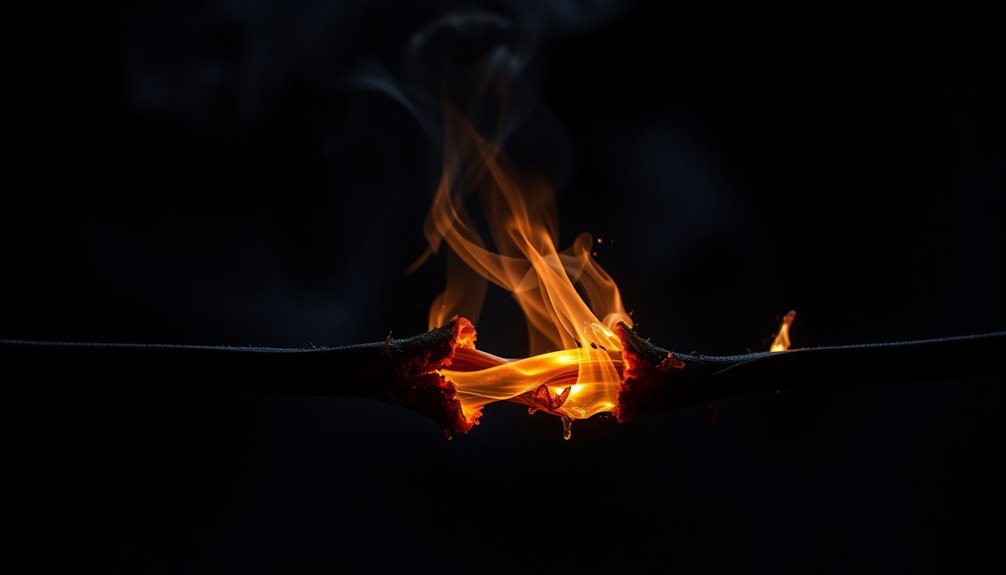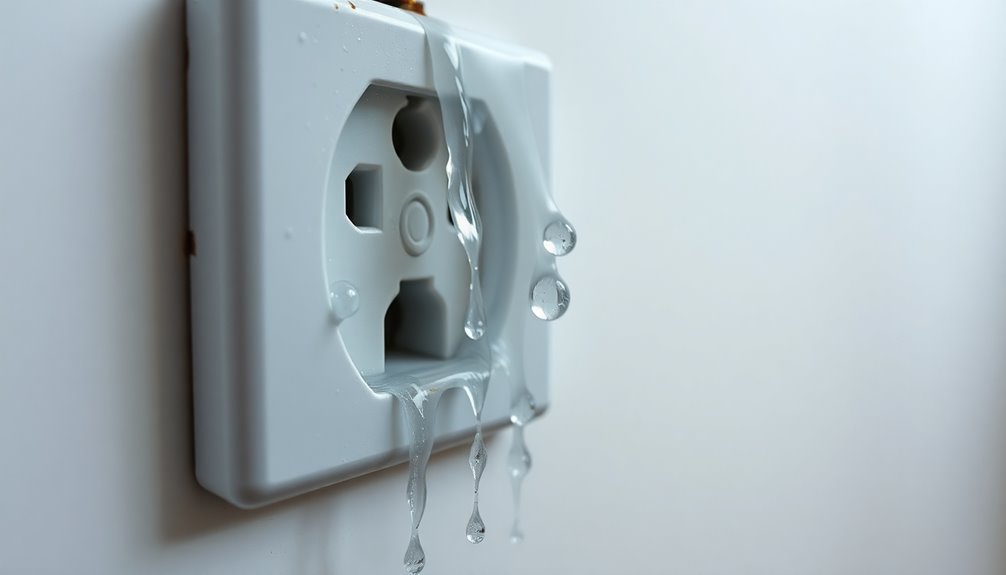To prepare your home for a fire inspection, make certain all fire safety equipment is properly maintained, including testing smoke and CO detectors monthly and replacing batteries or units as needed. Keep escape routes clear and well-marked, and ensure fire extinguishers are accessible, checked, and in good condition. Check electrical systems for hazards and continue ongoing safety education for everyone in your home. For step-by-step tips, you’ll discover how to meet all safety standards and pass with confidence.
Key Takeaways
- Ensure clear access to exits, escape routes, and fire safety equipment like extinguishers and detectors.
- Test and maintain smoke and CO detectors regularly, replacing batteries and cleaning sensors.
- Verify fire extinguishers are properly placed, accessible, and have current inspection tags and pressure gauges.
- Inspect electrical systems for hazards, fixing damaged wiring, overloaded outlets, and ensuring panel accessibility.
- Educate household members on fire safety protocols and conduct regular drills to ensure preparedness.
Understand the Fire Inspection Requirements

To guarantee your home passes a fire inspection, you need to understand the specific requirements set by local authorities. Start by reviewing the local fire department’s guidelines, which often detail safety standards for exits, fire-resistant materials, and storage practices. Check if there are regulations regarding clear access to fire extinguishers and proper signage. Some regions require specific clearance around heating equipment or electrical systems. It’s also important to know the inspection schedule and any documentation you might need to provide, such as permits or safety certificates. Visiting your local fire department’s website or calling their office can clarify these requirements. Knowing what’s expected helps you identify potential issues beforehand, making the inspection process smoother and increasing your chances of passing without costly corrections. Familiarity with fire safety standards can further ensure compliance.
Test and Maintain Smoke and Carbon Monoxide Detectors

Regularly testing and maintaining your smoke and carbon monoxide detectors is essential to guarantee they function properly during emergencies. You should test each detector at least once a month by pressing the test button until you hear the alarm sound. If it doesn’t activate, replace the batteries or the entire unit if necessary. Keep the detectors clean by gently dusting or vacuuming the sensors to prevent dust buildup that can impair their function. Replace batteries at least once a year, or immediately if you hear a low-battery chirp. Also, follow the manufacturer’s instructions for replacing the detectors themselves—most last about 8-10 years. Proper maintenance ensures your detectors will alert you promptly, providing critical early warnings during a fire or carbon monoxide leak. Using vetted home safety products can further enhance your home’s preparedness and safety measures.
Clear and Mark Emergency Escape Routes

Make sure your escape routes are free of clutter so you can leave quickly in an emergency. Use clear signs or markings to indicate the safest exits, even in low visibility. Keeping pathways open and well-marked guarantees everyone can evacuate safely when needed. Regularly assessing and reassessing your space can help prevent clutter buildup and ensure your escape routes remain clear.
Keep Pathways Unobstructed
Ensuring your pathways are unobstructed is essential for a safe and efficient fire inspection. Clear hallways, stairwells, and doorways allow quick and safe escape during an emergency. Remove clutter such as furniture, boxes, or personal items that block exits or hinder movement. Keep pathways free of cords or cables that could cause trips or delays. Regularly check high-traffic areas to ensure nothing has been left in the way. Properly store household items, tools, and equipment to prevent accidental obstruction. Remember, fire inspectors look for clear routes that facilitate fast evacuation. Maintaining unobstructed pathways not only helps during inspections but also ensures your family’s safety in an emergency. Make it a habit to keep all escape routes free of obstructions at all times. Regular inspections of your home’s safety features can help identify potential hazards before they become emergencies.
Clearly Mark Escape Routes
Clearly marking your escape routes helps everyone in your home find their way quickly during an emergency. Use bright, visible signs or tape to indicate exits and pathways leading outside. Make sure doors and windows that serve as escape points are easily identifiable, with handles and locks clearly labeled. Keep these routes free of obstacles so everyone can move swiftly without hesitation. Consider adding glow-in-the-dark tape or signs in hallways and stairwells for better visibility in low light or power outages. Regularly check that markings remain clear and unobstructed. Properly marked routes are a crucial part of your overall fire safety plan. Additionally, understanding projector placement and ensuring clear pathways can be analogous to maintaining clear escape routes, emphasizing the importance of unobstructed access in safety planning.
Inspect and Store Fire Extinguishers Properly

Make certain your fire extinguishers are easy to access and placed in prominent locations. Check regularly to confirm they’re in good condition and ready to use. Proper placement and consistent inspection help ensure you’re prepared in an emergency. Additionally, understanding the best fire extinguishers for your home can enhance safety and effectiveness.
Check Extinguisher Accessibility
To make certain you can respond quickly in an emergency, it’s essential to check that fire extinguishers are easily accessible. Ensure they are not blocked by furniture, storage boxes, or other obstacles. Verify that extinguishers are mounted at the correct height—typically around waist level—so you can grab and operate them swiftly. Confirm the pressure gauges are in the operable range, and look for any signs of damage or corrosion. Make a habit of performing quick visual inspections monthly to guarantee accessibility. Keep the area around each extinguisher clear and free of clutter, so you won’t waste precious seconds searching for it during a fire. Properly accessible extinguishers can make a critical difference in controlling a fire early and protecting your home. Regular building safety checks ensure your fire prevention measures remain effective.
Ensure Proper Placement
Proper placement of fire extinguishers guarantees quick access when every second counts. You should mount extinguishers on walls in visible, high-traffic areas like the kitchen, garage, or near exits. Keep them at least 3.3 feet above the floor so they’re easy to grab. Avoid placing extinguishers behind doors, in closets, or in hard-to-reach spots. Make sure they’re close enough to potential fire sources but not obstructed by furniture or clutter. Check the manufacturer’s instructions for specific mounting height and placement guidelines. Regularly confirm that extinguishers are easily accessible and not blocked by anything. Proper placement ensures you can grab the extinguisher quickly during an emergency, reducing damage and protecting your home and loved ones. Ensuring proper fire safety protocols can greatly enhance your preparedness in case of a fire.
Maintain Regular Inspection
Regularly inspecting your fire extinguishers guarantees they’re ready to use when you need them most. Check the pressure gauge to ensure it’s in the operable range, and look for any visible damage or corrosion. Make sure the pin and tamper seal are intact. Confirm the extinguisher is securely mounted and easily accessible. Proper storage and routine checks prevent malfunctions during emergencies. Use the table below to guide your inspection process:
| Inspection Step | What to Check | Frequency |
|---|---|---|
| Pressure gauge | Ensures proper pressure | Monthly |
| Physical condition | No damage or corrosion | Monthly |
| Accessibility | Clear path and proper mounting | Weekly |
| Recharge status | Fully charged or needs refill | Annually or after use |
Consistent inspections keep your fire extinguishers reliable and ready for action. Maintaining safety standards is essential to ensure your home remains compliant during fire inspections.
Check Electrical Systems and Remove Hazards

Before the fire inspector arrives, you need to thoroughly examine your electrical systems for potential hazards. Start by inspecting outlets and switches for scorch marks, frayed wires, or loose connections. Next, test cords and extension cords for damage—discard any that are cracked or frayed. Finally, ensure all electrical panels are accessible, labeled, and free of overloads. Here’s what to focus on:
- Check for damaged wiring or outlets and replace or repair as needed.
- Unplug unused appliances to prevent overheating or electrical fires.
- Avoid overloading circuits by spreading out high-power devices across different outlets.
- Regularly inspecting your electrical system helps maintain safety and prevents fire hazards, ensuring your home is up to code and secure.
Keep Fire Exit Pathways Unobstructed

Ensuring fire exit pathways are unobstructed is crucial for a quick and safe evacuation during an emergency. Clear exits help prevent delays and injuries when seconds count. Regularly check hallways, stairwells, and doorways to guarantee nothing blocks your way. Keep furniture, storage items, and clutter away from exit routes. Maintain proper lighting so pathways are visible at all times. To help you stay organized, consider this overview:
| Area to Check | Potential Obstacle | Action Needed |
|---|---|---|
| Main Hallway | Boxes, shoes, furniture | Clear debris and clutter |
| Staircase | Personal belongings, rugs | Remove obstructions |
| Exterior Doors | Bicycles, trash cans | Keep clear at all times |
| Basement Exits | Storage items, tools | Maintain free access |
| Windows & Doors | Curtains, decorations | Keep pathways accessible |
Keeping pathways open ensures you’re prepared for a safe evacuation.
Review and Update Fire Safety Plans

To keep your fire safety measures effective, you need to review and update your fire safety plans regularly. This ensures they reflect any changes in your home or household. First, assess your current plan to identify outdated or missing information, like new appliances or modified escape routes. Second, update emergency contacts and make sure everyone knows who to call during a fire. Third, test your fire safety equipment—smoke alarms, fire extinguishers, and escape ladders—and replace or service them if needed. Regular reviews help you spot potential hazards and keep everyone prepared. By maintaining an up-to-date plan, you ensure your household reacts quickly and effectively in an emergency, reducing risks and protecting your home.
Educate Household Members or Employees on Fire Safety

Educating household members or employees on fire safety is essential for effective emergency response. When everyone understands fire risks and safety procedures, you minimize confusion during a crisis. Start by teaching basic fire prevention tips, like avoiding overloaded outlets and keeping flammable materials away from heat sources. Make sure everyone knows how to properly use fire extinguishers and where they’re located. Conduct regular fire drills so that everyone practices evacuating quickly and safely. Emphasize the importance of alerting others immediately if a fire occurs. Clear communication and repeated training help build confidence and ensure swift action. Remember, well-informed household members or employees can prevent fires and respond effectively, reducing damage and protecting lives during emergencies.
Schedule a Pre-Inspection Walkthrough

Have you scheduled a pre-inspection walkthrough yet? This step helps guarantee your home is ready and highlights potential issues before the official inspection. During the walkthrough, focus on these key areas:
- Identify hazards: Check for blocked exits, faulty wiring, or combustible materials stored improperly.
- Test safety equipment: Ensure smoke detectors, fire extinguishers, and alarms are functional and accessible.
- Review fire escape routes: Confirm all escape paths are clear, well-lit, and known to everyone in the household.
Conducting this walkthrough allows you to address problems proactively, reducing the risk of surprises during the actual inspection. It also gives you confidence that your home meets fire safety standards, helping you pass with minimal issues.
Frequently Asked Questions
How Often Should Fire Safety Equipment Be Professionally Inspected?
You should have your fire safety equipment inspected professionally at least once a year to guarantee everything works properly. Regular inspections help catch any issues early, like faulty alarms or empty fire extinguishers, so you’re prepared in an emergency. If you have complex systems or recent changes, consider more frequent checks. Staying proactive maintains your safety and helps you pass fire inspections easily.
Are There Specific Fire Codes for Different Types of Homes?
You should verify local fire codes because they vary for different home types. For example, single-family homes often follow residential codes, while multi-family or commercial buildings have stricter regulations. These codes specify requirements for smoke alarms, fire extinguishers, and escape routes. To stay compliant, contact your local fire department or building authority, and ensure your home meets the specific standards applicable to its type and use.
What Common Mistakes Lead to Failed Fire Inspections?
Imagine the inspector knocking, your heart racing as they review your home. Common mistakes that cause failure include clutter blocking exits, faulty electrical wiring, missing smoke detectors, and improper storage of flammable materials. You might overlook small hazards, but they add up quickly. Stay vigilant—regularly check your safety devices, clear escape routes, and ensure proper storage. These steps can catch mistakes before the inspector does and keep your home safe.
Can Local Fire Departments Provide Safety Consultations?
Yes, local fire departments often offer safety consultations to help you identify potential hazards and improve your home’s fire safety. You can request a visit, where experts assess your property and provide tailored advice on fire prevention measures. Taking advantage of these consultations can guarantee you’re well-prepared, meet safety standards, and reduce the chances of failing a fire inspection. Always contact your local department to schedule a consultation.
How Do I Document Compliance for Fire Inspection Requirements?
You document compliance by gathering all relevant records and evidence. Keep a detailed checklist of fire safety measures, such as working smoke alarms, fire extinguishers, and clear exits. Take photos of these features and maintain maintenance logs. Confirm all inspections, fire drills, and safety upgrades are well-documented. Present this organized information during the fire inspection to demonstrate your home meets safety standards, making the process smoother and more efficient.
Conclusion
By thoroughly preparing your home for fire inspection, you’re not just checking boxes—you’re safeguarding your entire world. Imagine the relief of knowing you’ve done everything possible to protect your loved ones from the unimaginable. Don’t wait until disaster strikes; take action now and turn your home into an impenetrable fortress of safety. Every step you take today could be the difference between life and death tomorrow. Be relentless—your safety depends on it.









